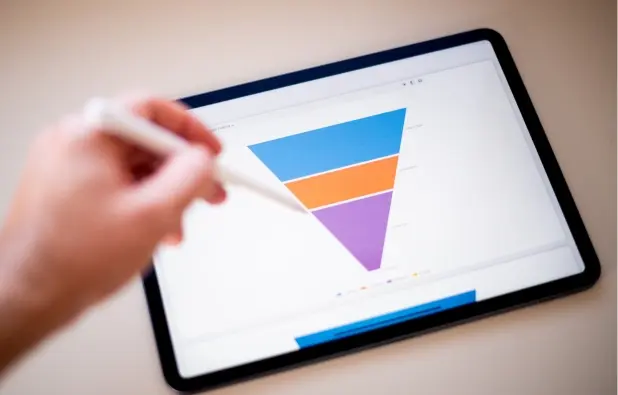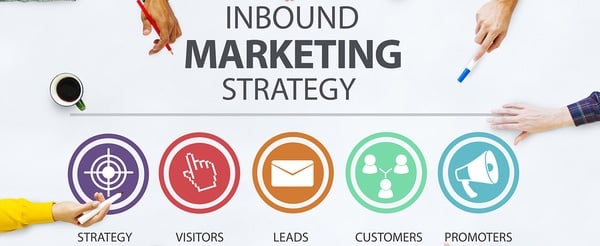Current B2B Content Marketing Trends to Help You Stay Ahead
Understanding B2B content marketing trends is key to staying competitive. As the industry evolves, marketers are faced with rapid advancements like...
5 min read
Inbound 281
June 24, 2025 9:30:00 AM EDT

To turn leads into loyal customers, you need more than just great content; you need the right content at the right time. That’s where the B2B marketing funnel comes in. It maps the buyer’s journey from awareness to purchase and helps you deliver content that moves prospects closer to a decision.
In this guide, we’ll break down each stage of the funnel and show you exactly what types of content work best. Whether you’re just starting or refining your strategy, aligning content with the B2B marketing funnel will improve engagement, shorten sales cycles, and drive more qualified leads.
The B2B marketing funnel outlines the path a buyer takes, from discovering a problem to becoming a customer and advocate. At each stage, buyers have different needs, questions, and goals, so your content strategy needs to adapt.
Here’s a quick breakdown of the three main stages:
Awareness: The buyer realizes they have a challenge and begins researching. Content should educate, not sell.
Consideration: The buyer explores solutions. Content should compare options and highlight your expertise.
Decision: The buyer is ready to choose. Content should build confidence and support a clear path to purchase.
At the top of the B2B marketing funnel, buyers are just beginning to explore a problem or opportunity. They’re seeking information, clarity, and perspective. This is your opportunity to earn their attention by offering helpful, educational content.
In the Awareness stage, buyers want to understand trends, find answers to common pain points, and see what’s possible in their industry.
Your content should help buyers:
Recognize and define a challenge or opportunity.
Understand current trends and industry context.
Learn something valuable without being sold to.
Your role is to position your brand as a trusted resource early in their journey.
Blog posts – Answer common questions and introduce key topics in your industry.
Infographics – Break down complex ideas or data into digestible visuals.
Thought Leadership Articles – Share expert insights and unique perspectives.
Industry Reports or Surveys – Provide credible, data-backed findings.
Social Media Content – Offer quick tips or insights that drive engagement and traffic.
This content should be high-value, easy to consume, and designed to generate interest, not conversions.
Use clear, keyword-focused headlines to improve search rankings (e.g., “How the B2B Marketing Funnel Is Evolving in 2025”).
Keep formatting scannable with subheadings, bullets, and visuals.
Publish consistently to stay top-of-mind and establish credibility over time.
Include soft calls-to-action that encourage deeper exploration (e.g., “Learn more,” “Read the full guide”).
By delivering relevant content at this stage, you begin building trust, making it more likely your brand will be remembered and considered as buyers move further through the B2B marketing funnel.
At the consideration stage of the B2B marketing funnel, your prospects are actively evaluating solutions. They’ve identified their problem and are now comparing vendors. This is your opportunity to prove your value, build trust, and help buyers make informed decisions.
Buyers at this stage are seeking specifics: solution options, proof points, and vendor credibility. The more closely your content speaks to their intent and pain, the more effective it becomes.
Focus your content strategy by:
Using search and CRM data to anticipate buyer questions.
Creating topic clusters around “how,” “why,” and “what if” queries.
Highlighting practical advice and real-world applications.
Addressing objections around cost, risk, and internal buy-in early.
Speaking directly to challenges like implementation complexity or ROI helps buyers envision your solution as the best fit.
The right formats help buyers evaluate your offering and advocate for it internally. Strong consideration-stage content includes:
Case Studies – Real examples with metrics show what success looks like.
Webinars & Q&As – Live, expert-led sessions build authority and invite interaction.
White Papers & Solution Guides – Data-driven resources that explain your approach in depth.
Comparison Sheets – Honest side-by-sides that highlight what sets you apart.
Visual content increases clarity and engagement, especially when explaining complex ideas or software solutions. Consider adding:
Explainer Videos or Product Demos – Help prospects grasp functionality and benefits quickly.
ROI Calculators or Configurators – Allow leads to explore your offering at their own pace.
Interactive Assessments – Help prospects self-identify their needs and ideal solution path.
Not all stakeholders care about the same things. Tailoring your content by role ensures your message hits the mark.
Technical Leads - Focus on integration, uptime, and support.
Finance - Prioritize ROI, pricing, and total cost of ownership.
End Users - Emphasize ease of use, training, and productivity gains.
Create alternate versions of key content pieces that speak to different decision-makers across the buying committee.
Be clear and direct, avoid jargon or vague claims.
Use visuals and interactivity to hold attention.
Include measurable results wherever possible.
End with logical CTAs: “Download the guide,” “Watch the demo,” or “Book a strategy session.”
Done right, your middle-of-funnel content removes roadblocks and positions your business as the obvious choice.
At the bottom of the B2B marketing funnel, prospects are ready to make a choice. Now, they want proof: real results, clear value, and a smooth path to purchase. Your content should build confidence, eliminate hesitation, and drive the final decision.
Buyers need to feel secure in their investment and trust that your solution will deliver.
Effective bottom-of-funnel formats include:
Product Demos – Let prospects see your solution in action. Demonstrate key features, use cases, and time-saving benefits.
Customer Testimonials & Case Studies – Share success stories with specific outcomes to reinforce credibility.
ROI Calculators & Value Assessments – Help buyers project potential gains like efficiency, revenue, or cost savings.
Detailed Comparison Sheets – Offer side-by-side charts to clearly highlight your advantages over competitors.
Your messaging should be laser-focused on what matters most to the decision-maker: outcomes, ease of adoption, and risk mitigation.
Address these key areas:
Tangible results (backed by numbers, where possible).
Fast, smooth implementation timelines.
Ongoing support, training, and onboarding resources.
Transparency around pricing, terms, and guarantees.
If buyers still have lingering concerns, use:
FAQ documents to address common last-minute questions.
Consultations or live Q&As to resolve uncertainties in real time.
Clear documentation outlining service levels, processes, or timelines.
Once buyers are convinced, make it easy to take action. Every bottom-of-funnel asset should include a direct, compelling call to action.
Examples include:
Book a demo
Request a quote
Start a free trial
Schedule a consultation
Incentives like limited-time offers or bundled services can also help encourage quicker decisions, just ensure they’re relevant and not gimmicky.
This stage is where tight alignment between marketing and sales pays off. Share lead engagement insights with your sales team, including what the prospect has viewed, clicked, downloaded, or asked.
When your sales team knows what the buyer has already seen and what matters to them:
Follow-up is faster and more personalized
Conversations move forward with fewer delays
Close rates improve
A smooth transition from content to conversation is what ultimately turns an interested lead into a loyal customer.
The most successful B2B marketing strategies don’t guess what content to use; they map it to the buyer’s journey. By aligning your content with each stage of the B2B marketing funnel, you create a smoother path from awareness to action, building trust and momentum along the way.
When every piece of content is designed to educate, guide, and convert at the right time, your funnel stops leaking and starts performing.
At Inbound 281, we help B2B companies create content strategies that speak directly to decision-makers at every stage. Whether you're building awareness, nurturing interest, or driving conversions, our team knows how to turn strategy into results.
Let’s talk about how we can help you fuel your funnel. Contact us today or schedule a meeting with our advisor to find out more about how we can help guide your leads through the b2b marketing funnel using content that works.

Understanding B2B content marketing trends is key to staying competitive. As the industry evolves, marketers are faced with rapid advancements like...

Though B2B consumers continue to indicate a preference for inbound marketing over more traditional marketing methods, some B2B companies have been...

Video marketing is now considered to be a key driver in b2b marketing. Businesses use video to attract leads, keep prospects engaged, and boost...